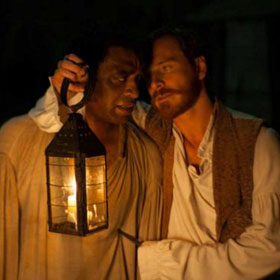'12 Years A Slave' Review: A Heartbreakingly Beautiful Portrait Of Slavery

5/5
Director Steve McQueen’s follow up to 2011’s Shame, 12 Years A Slave, features the director’s trademark long takes and fantastic cinematography to create a truly beautiful film about one of the ugliest times in United States history.
McQueen’s last two films, Shame (2011) and Hunger (2008), also depicted topics ‘Hollywood’ films (and mainstream culture) choose to push under the rug, such as sex addiction, sexual abuse, corrupt justice and more. What McQueen’s films all have in common is a beautifully tragic sensibility, in which every frame seems to be bringing the main character, and the audience, closer and closer to unavoidable death and despair. Never has this been more clear than in 12 Years A Slave.
12 Years A Slave is based on the true story of Solomon Northup (Chiwetel Ejiofor), a free black man who is kidnapped in the North by two white men and trafficked into slavery in the South in the 1840s. Solomon must endure the attempted robbing of his identity, his freedom and his will to fight for a life beyond enslavement. As Solomon, Ejiofor delivers a solid performance, and it is impossible not to be entranced by Solomon’s journey. (Unless you have no heart and no sense of human decency.)
While enslaved, Solomon is forced to witness a reality that he and his family prefer not to think about. He witnesses a mother, Eliza (played by the superb Adepero Oduye), be ripped from her young children. He learns to check himself when he sees his ruthless Master Epps (Michael Fassbender) abuse and torture Patsey (Lupita Nyong’o).
Fassbender is phenomenal as the endlessly cruel Epps, setting the tone for every scene he’s in. Fassbender's unique ability to make even the most heartless of acts appear somewhat meaningful has never been more striking than in this film. It helps that his scene partners equally strong. Particularly Sarah Paulson, who plays his scorned wife. Paulson has a small, but biting role in the film, and her outbursts often received the strongest reactions from the audience.
What is curious about the narrative of 12 Years A Slave is the unspoken, unaddressed helplessness slaves and/or African Americans felt towards each other. Many slaves in the film bond, or form small alliances of sorts, but if one is given the chance to survive, he or she barely thinks twice about leaving the other behind. When Solomon sees a slave as a free man, he averts his eyes, for he knows there is nothing he can do to help without sacrificing himself and his family.
The questionable morality of witnessing injustice and not acting is also explored through the characters of slave owner Ford (Benedict Cumberbatch) and eventual ally Bass (Brad Pitt). Pitt’s role is small, and for that, I am grateful. It’s not that Pitt is a bad actor, but his immaculate appearance while working out in the hot sun was a bit too larger than life for the movie. He looked like he had just come off the red carpet instead of like a tired, abolitionist Canadian carpenter.
That said, no amount of talent in front of the camera could have made the film half of what it is without director Steve McQueen. McQueen’s manipulation of lighting and sound work seamlessly to create Solomon’s ominous journey south. When Solomon realizes he has been captured and shackled, then when he is ferried on a boat down south, carted through the woods and eventually sold, the music accompanies him, becoming more sinister by the second. The music, composed by Hans Zimmer (Inception, Gladiator), builds with every step Solomon takes towards his enslavement, which is, essentially, every step he takes away from his own identity, making every sound, every note an assault on the viewer, reflecting Solomon’s horrific journey.
McQueen’s use of sound is extremely well calculated and methodical. While some may feel the urge to close their eyes when Solomon is beaten with the whip, or when women cry out for their children that are sold right in front of their eyes, it is impossible to escape the sounds the whip makes when it connects with the flesh or the sound of a person sobbing. The audience is trapped, assaulted through sight and sound; the film elicits an intense physical reaction from the viewer. It feels both impossible to watch and impossible to look away.
RELATED ARTICLES
Get the most-revealing celebrity conversations with the uInterview podcast!






Leave a comment